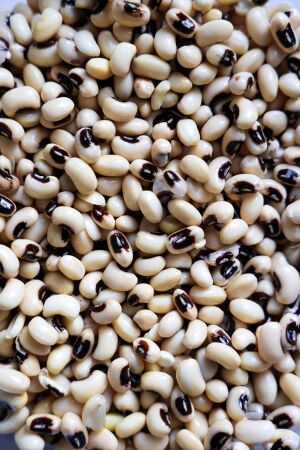Science:Black-eyed pea
Black-eyed pea
 | |
| Caption | Black-eyed peas |
|---|---|
| Name | Nyebe (Wollof) |
| Type | Natural |
| Origin | |
Summary
Black-eyed peas, originally domesticated in West Africa around 6,000 years ago, are actually beans related to cowpeas [1] They spread to Egypt by 2500 BC and later to the Mediterranean, South Asia, and Central Asia[2].The crop was brought to the Americas in the 1600s by enslaved Africans during the transatlantic slave trade[3][4] Initially considered livestock feed and food for enslaved people, black-eyed peas became a staple in Southern cuisine[5][6] They gained cultural significance, particularly as a symbol of luck when eaten on New Year's Day[7] Today, black-eyed peas are cultivated worldwide and remain an important part of African American culinary heritage[8][9]
 | |
| Caption | Black-eyed peas |
|---|---|
| Name | Nyebe (Wollof) |
| Type | Natural |
| Origin | |
History
Black-eyed peas have a rich history that begins in West Africa, where they were first domesticated approximately 6,000 years ago[10] These legumes, scientifically known as Vigna unguiculata, originated in the region that includes parts of present-day Nigeria, Niger, and Burkina Faso[11] From their West African origins, they spread across the continent and eventually made their way to Egypt by 2500 BCE, before spreading further to the Mediterranean, South Asia, and Central Asia through ancient trade routes[12]The journey of black-eyed peas to the Americas is intrinsically linked to the transatlantic slave trade of the 1600s[13] Enslaved Africans brought these beans with them, either deliberately or sometimes as provisions on slave ships[14]In Brazil, black-eyed peas became an essential ingredient in dishes like acarajé, a popular street food in Bahia state[15]ref> Acarajé consists of black-eyed peas that are peeled, mashed into a paste, seasoned with salt and onions, then formed into balls and deep-fried in dendê (palm oil)[16]In the United States, black-eyed peas took on particular significance in the American South[17] Initially considered suitable only for livestock feed and sustenance for enslaved people, they gradually became an integral part of Southern cuisine[18] The most famous black-eyed pea dish in the American South is Hoppin' John, a preparation of black-eyed peas cooked with rice, pork (usually bacon or ham hocks), and seasonings[19]A particularly significant tradition emerged around eating black-eyed peas on New Year's Day, especially in the American South[20]This custom is believed to bring good luck and prosperity for the coming year. The peas are often served with collard greens (representing money) and cornbread (representing gold), creating a meal rich in both nutrition and symbolism[21]In contemporary African American cuisine, black-eyed peas are prepared in numerous ways[22] The versatility of black-eyed peas in these cuisines demonstrates their enduring importance in the African diaspora[23]Their journey from West African staple to global ingredient mirrors the complex history of African peoples in the Americas, while their continued presence in contemporary cuisine helps maintain cultural connections across generations and continents[24]
Principles
Key Developments
Applications
Bibliography
References
- ↑ "SeedWorld USA",Full text .
- ↑ "SeedWorld USA",Full text
- ↑ "Food Network",Full text
- ↑ "Nature's Produce",Full text .
- ↑ "Food Network",Full text
- ↑ "1840 Farm",Full text .
- ↑ "Food Network",Full text .
- ↑ "Wikipedia",Full text
- ↑ "The Spruce Eats",Full text .
- ↑ "SeedWorld USA",Full text .
- ↑ "Wikipedia",Full text .
- ↑ "SeedWorld USA",Full text .
- ↑ "Nature's Produce",Full text .
- ↑ "Civil War Talk",Full text .
- ↑ "The Spruce Eats",Full text .
- ↑ "Capital B News",Full text .
- ↑ "Food Network",Full text .
- ↑ "1840 Farm",Full text .
- ↑ "Rambling Man's Adventures",Full text .
- ↑ "Food Network",Full text .
- ↑ "1840 Farm",Full text .
- ↑ "The Spruce Eats",Full text .
- ↑ "Capital B News",Full text .
- ↑ "Wikipedia",Full text .